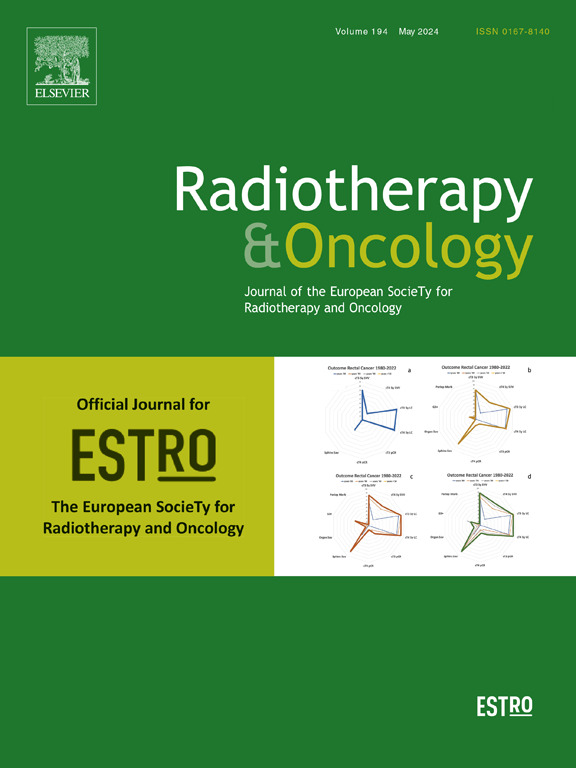A systematic review and proportional meta-analysis of image-based pattern of loco-regional failure analyses outcomes in head and neck squamous cell carcinoma
IF 4.9
1区 医学
Q1 ONCOLOGY
引用次数: 0
Abstract
Background and purpose
The prognosis following loco-regional failure after primary radiotherapy (RT) for head and neck squamous cell carcinoma (HNSCC) is poor. The hypothesis that most failures occur as a consequence of tumor radioresistance, can be evaluated by proxy as the proportion of failures that occur in the high-dose region. Several studies have investigated possible reasons for treatment failure by an image-based pattern of failure analyses (POF), comparing the initial planning CT scan with a scan conducted upon failure. The aim of the present systematic review and meta-analysis was to evaluate the proportion of failures that occurred in the high-dose region of all analyzed failures.
Materials and Methods
A systematic database search from 2000 to 2023, was performed for studies including results from image-based loco-regional POF, regardless of the method, after primary RT for HNSCC. Proportions of volumetrically in-field (opposed to marginal or outfield) failures, point of origin-based inside high-dose targets, or covered by curative doses for both the number of patients and the number of failure sites were analyzed in proportional meta-analyses.
The review was registered at Prospero (CRD42023412545).
Results
Out of 56 included studies, accumulated image-based POF results were available from 1,161 patients and 658 individual failure sites. The majority of patients had in-field failures in volumetric-based studies (84 % (95 % CI: 77;90)), inside failures in point of origin-based studies (82 % (95% CI:61;85)) or failures covered by 95 % of dose prescribed to CTV1 (84 % (95% CI:69;95)). A trend toward increasing proportions of non-high-dose failures in more recently treated patients was observed.
Conclusion
Most loco-regional failures for patients treated with primary RT for HNSCC are related to the high-dose volume. Therefore, a focus on biomarkers predicting individual tumor radiosensitivity is warranted to enable individualized treatment intensification to increase loco-regional control.
系统回顾和比例荟萃分析基于图像模式的局部-区域失败分析头颈部鳞状细胞癌的结果。
背景与目的:头颈部鳞状细胞癌(HNSCC)初次放疗(RT)局部区域失败后预后较差。大多数失败是肿瘤放射抵抗的结果,这一假设可以通过在高剂量区域发生失败的比例来评估。一些研究通过基于图像的失败分析模式(POF)调查了治疗失败的可能原因,比较了最初计划的CT扫描和失败后进行的扫描。本系统综述和荟萃分析的目的是评估所有分析失败中发生在高剂量区域的失败比例材料和方法:对2000年至2023年的研究进行了系统的数据库检索,包括基于图像的局部区域POF的研究结果,无论采用何种方法,在HNSCC的初次放疗后。在比例荟萃分析中,对患者数量和失败部位数量的体积内(相对于边缘或外场)失败、基于起始点的高剂量靶点内失败或治疗剂量覆盖的比例进行了分析。该综述已在Prospero注册(CRD42023412545)。结果:在56项纳入的研究中,累积的基于图像的POF结果来自1161名患者和658个单独的失败部位。在以体积为基础的研究中,大多数患者有现场失败(84% (95% CI: 77;90)),在以起点为基础的研究中有内部失败(82% (95% CI:61;85)),或在95%的CTV1处方剂量范围内失败(84% (95% CI:69;95))。观察到在最近治疗的患者中,非高剂量失败的比例呈增加趋势。结论:原发性肝癌原位放疗患者局部-区域失败与大剂量放疗有关。因此,有必要关注预测个体肿瘤放射敏感性的生物标志物,以实现个体化治疗强化,增加局部区域控制。
本文章由计算机程序翻译,如有差异,请以英文原文为准。
求助全文
约1分钟内获得全文
求助全文
来源期刊

Radiotherapy and Oncology
医学-核医学
CiteScore
10.30
自引率
10.50%
发文量
2445
审稿时长
45 days
期刊介绍:
Radiotherapy and Oncology publishes papers describing original research as well as review articles. It covers areas of interest relating to radiation oncology. This includes: clinical radiotherapy, combined modality treatment, translational studies, epidemiological outcomes, imaging, dosimetry, and radiation therapy planning, experimental work in radiobiology, chemobiology, hyperthermia and tumour biology, as well as data science in radiation oncology and physics aspects relevant to oncology.Papers on more general aspects of interest to the radiation oncologist including chemotherapy, surgery and immunology are also published.
 求助内容:
求助内容: 应助结果提醒方式:
应助结果提醒方式:


